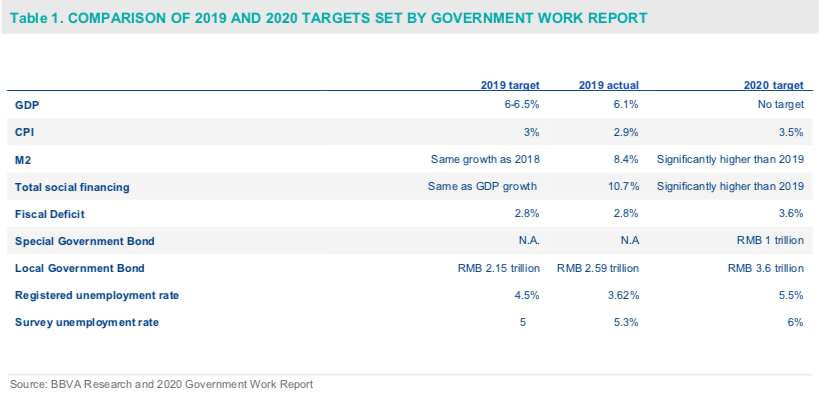Dong Jinyue and Xia Le: Main Takeaways from Government Work Report at “Two Sessions”
2020-05-25 IMI
The long-awaited “two-sessions” of China, namely the annual sessions of the National People’s Congress (NPC) and the Chinese People’s Political Consultative Conference (CPPCC), commenced in Beijing on May 21st after a two-month delay due to the COVID-19 outbreak. The “two sessions” are always a pivotal event in China’s political calendar. At this challenging moment, the convention of the “two sessions” signals that the COVID-19 outbreak has been brought under control in China.
In the week-long sessions, delegates from around the country will discuss the most important issues concerning all dimensions of national affairs, ranging from economic-social development to geopolitical security. This year’s “two sessions” are held in the aftermath of the COVID-19 outbreak, which has transformed to a pandemic with catastrophic impact on the global economy. The COVID-19 containment and economic stimulus are key topics this time. Other topics include every perspective of Chinese society including poverty alleviation, property market, industry policy, deterioration of the China-US relationship and climate change etc.
On May 22th, in the third session of the 13th National People's Congress (NPC), Premier Li Keqiang delivered the Government Work Report. The report not only summarized the achievements of China in 2019 but also made a blueprint of every perspective of economic and social development for 2020. Here are the main takeaways:
No GDP growth target was set for 2020. Traditionally, the authorities announce several official targets for the year at the NPC, including the annual GDP growth target. However, the routine could be broken this year. No GDP target was announced in this year’s Government Work Report for 2020. As its major important trade partners are still suffering the pandemic, China’s external demand is now facing enormous uncertainties. Setting an officially binding growth target at such a juncture could cost the authorities the necessary flexibility of balancing growth boost and long-term debt control in the implementation of economic stimulus.
Employment protection is the first priority among the “Six Stabilities” and “Six Protections”: As we expected, the Government Work Report again emphasized the importance of the new slogan of “Six stabilities” and “Six Protections”, including stabilizing employment, financial sector, foreign trade, foreign investment, domestic investment and expectations. Chief among them is the employment stability amid the economic recession and COVID-19. It is noticed that although the Report does not set the GDP growth target, but it indeed set the unemployment rate target at 5.5% for registered unemployment rate and 6% for survey unemployment rate for 2020. (Table 1)
Proactive fiscal policy will support a stimulus package of 5% of GDP. The Government Work Report also clearly listed the fiscal stimulus measures amid COVID-19 and global economic recession, including: (i) To expand fiscal deficit rate from 2.8% in the previous year to 3.6%, around RMB 1 trillion increasing; (ii) To issue special government bond with the scale of RMB 1 trillion; (iii) To increase tax cut and fee reduction scale to RMB 2.5 trillion, RMB 0.5 trillion increasing from the previous year ; (iv) To expand local government bond issuance to RMB 3.75 trillion to support infrastructure investment at local government level, increasing by RMB 1.6 trillion from the previous year; and (v) To use part of proceeds from local government bond issuance as seed funds to leverage bank lending, estimated at RMB 1.4 trillion. Altogether, the fiscal stimulus package reaches RMB 3.6 trillion, around 3.6% of total GDP. Last but not least, in order to finance the fiscal easing measures, the Report set the central government expenditure growth to negative this year. (Table 1)
Prudent monetary policy will be more flexible to support growth. The report announced that the central bank will implement multiple conventional monetary measures such as interest rate cut, RRR cut, re-lending to lead M2 and total social financing growth significantly higher than the previous year in a bid to stimulate growth. In addition, the report also mentioned to promote monetary policy tool innovation to make the monetary transmission mechanism smoother and more targeted to SMEs (such as to extent SMEs debt repayment date etc.).
The focus of industry policy will shift to developing “new infrastructure” this year. In terms of the industry policy, this year’s Report emphasized the support for the new infrastructure investment, new urbanization and heavy industry infrastructure investment such as water conservancy and communication infrastructure. To support “New infrastructure” to stimulate growth has been a recent hot topic, including information-based infrastructure such as 5G and the Internet of Things; converged infrastructure supported by the application of the internet, big data and artificial intelligence, such as smart transportation and smart energy infrastructure; and innovative infrastructure that supports scientific research, technology development and product development.

Altogether, this year’s “two sessions” is special compared with the previous ones at this challenging COVID-19 stage. The top priority of this year’s “two sessions” centering around COVID-19 pandemic containment and economic stimulus measures. We believe that the pro-growth measures announced in the Government Work Report will help to put China’s growth engine back to the right track in Q2 and afterwards, and ultimately Chinese economic bounce will lead global economic recovery in the next year. Altogether, we predict the GDP growth rate will steadily climb up to 2% y/y in Q2, 5% y/y in Q3 and 7% y/y in Q4, concluding 2020 with a full-year growth outturn of 2.2%.
